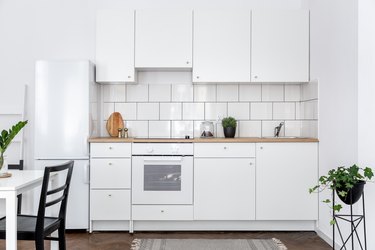
A musty smell in the kitchen cabinets can be annoying, but it can also mean there is a bigger issue, such as a water leak or decaying material within the interior. If a dank and musty smell has settled deep into the wood or plastic of the cupboard, then there are a few ways to rid the unwanted odor from the confines of the cabinet.
Why Musty Smells Happen
Video of the Day
Deep cabinets, such as those under bathroom vanities or oddly angled in tight kitchens, can wind up with forgotten items that have decayed or water issues that have gone unnoticed until they make themselves known by the odor. A fishy smell in a kitchen cupboard could be due to an organic item left behind in the recesses of the cupboard.
Video of the Day
Better Homes & Gardens recommends that cabinets need cleaning once a year to ensure a musty smell doesn't settle into its material. Before rooting out the problem, remove all of the items from the cupboard. Thoroughly clean those that will be returned to the interior and clean the interior with warm water and a mild dish soap.
Kitchen Cabinet Deodorizer
There are a few ways to rid the musty smell in the kitchen cabinets, according to Molly Maid.
- Wipe down the inside with a mix of one part rubbing alcohol to one part vinegar and water with a few drops of mild dishwashing liquid. Wipe down the entire interior and doors of the cabinets.
- Make a thick paste of baking soda and warm water to take out tough stains. This will lift grease and grime as well as odors that cling to the porous material inside a cabinet. This also works well on plastic-coated shelving and cupboards with stains from dyes and pigments.
- To keep a musty odor at bay, place newspapers down on the bottom before placing items back in the cupboard. If the cabinet continues to smell musty or has whiffs of mold or mildew after the initial cleaning, then it requires a serious scrubbing with bleach to thoroughly rid the item of the seeped in scent.
When Water Is an Issue
A cabinet with interior temperatures of 70 to 75 degrees Fahrenheit and levels of humidity with a 30 to 50 percent range are ideal. Anything higher could mean there is a water leak. Check for cold or damp spots along the backwall, any sides that are attached to dishwashers or other appliances that use water and the floor of the interior of the cabinet. If moisture is found, work along faucet fixtures, pipes or water lines until you find a leak.
Use a hygrometer, found in hardware or big box home improvement stores, to measure the humidity levels in your home. If the humidity level in the area where the cabinets are installed is high, use a dehumidifier in the room to bring the level down. This should help to remove the smell and maintain a clean cabinet after you have done all the work of removing the damp smell in the kitchen cupboards.